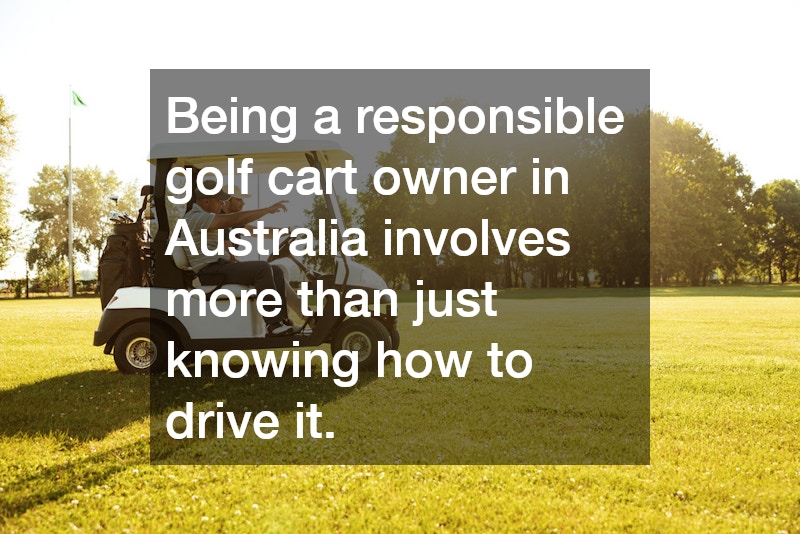Things You Should Know as a Golf Cart Owner
Owning a golf cart in Australia isn’t just about getting from one hole to the next on the green—it can also be a handy mode of transport around large properties, gated communities, retirement villages or resorts. There are a few essential things to know that will help you maximise its usefulness, remain compliant with relevant rules, and ensure it lasts for years to come.
From legal considerations and maintenance tips to battery care and storage, this guide will walk you through the key points every golf cart owner in Australia should understand.
Know the Laws and Regulations
Golf carts may seem like simple vehicles, but there are laws around their use, especially if you plan to operate one off the golf course. In most Australian states and territories, golf carts are not classified as motor vehicles under standard road laws. However, that doesn’t mean you can drive them anywhere.
Each jurisdiction has its regulations regarding the use of golf carts on public roads, paths or within gated communities. For example, Queensland allows golf buggies on certain roads under strict conditions, including registration, compliance with safety features (such as mirrors and indicators) and the driver holding a valid licence. In contrast, other states may have different restrictions or completely prohibit their use on public roads.
Before driving your golf cart outside private property, check with your local transport authority to ensure you comply with local laws. Non-compliance could result in hefty fines or penalties.
Battery Maintenance Is Essential
Most golf carts in Australia are electric and rely on deep-cycle batteries for power. These batteries are different from regular car batteries and require careful maintenance to ensure longevity and performance.
Firstly, always charge your golf cart after each use. Allowing the battery to run flat repeatedly can shorten its lifespan significantly. Use the manufacturer-recommended charger and avoid overcharging, which can also damage the battery over time.
Finally, maintain proper water levels if you have lead-acid batteries. Only use distilled water and ensure the battery is fully charged before refilling.
A well-maintained battery can last between 4 to 6 years, saving you money and reducing the risk of unexpected breakdowns.
Tyre Care and Suspension Checks
Although a golf cart is not a high-speed vehicle, it still requires attention to basic vehicle maintenance like tyre pressure and suspension components.
Under-inflated or worn-out tyres can lead to poor handling, increased wear on other components and reduced battery efficiency. Check your tyre pressure monthly and follow the manufacturer’s recommendations for inflation.
Suspension issues may not be immediately noticeable, but they can cause uneven wear and reduce the comfort of your ride. If you notice excessive bouncing, clunking noises or your golf cart sits unevenly, it may be time for a check-up.
Routine inspections help keep your cart safe, smooth and efficient, particularly if it is used regularly on uneven terrain or paved surfaces.
Invest in Proper Storage
A golf cart left outside in the elements will degrade much faster than one stored appropriately. Exposure to rain, sun and wind can cause the seat vinyl to crack, the paint to fade, and the battery to deteriorate.
Ideally, store your golf cart in a dry, covered space like a garage or carport. If that’s not possible, invest in a quality weatherproof cover to protect it from UV rays and moisture.
During extended periods of non-use, such as over winter or during travel, disconnect the battery and consider using a trickle charger to maintain a charge. This helps preserve battery health and ensures the vehicle is ready when you return.
Consider Insurance and Registration
Depending on how and where you use your golf cart, insurance and registration may be worth considering. Some private communities require carts to be insured against theft or damage, and others may ask for liability coverage in case of accidents involving pedestrians or property.
While not mandatory in many places, insurance can provide peace of mind, especially if your cart is an expensive model or used frequently. If you intend to operate the cart on designated public roads, you may also need to register it and fit safety gear like seatbelts, lights, and reflectors.
Always speak to your insurance provider about specific options for non-standard vehicles like golf carts.
Upgrades and Modifications
Once you’ve owned a golf cart for a while, you may consider upgrading it with features like all-terrain tyres, LED headlights or additional seating. While customisation can enhance functionality and comfort, be cautious about major modifications that could violate safety standards or local laws.
When in doubt, speak with a licensed golf cart technician or consult the manufacturer’s guidelines. Modifications should never compromise safety.
Being a responsible golf cart owner in Australia involves more than just knowing how to drive it. With the right knowledge and habits, owning a golf cart can be a convenient, eco-friendly, and enjoyable experience for years to come.



